Rising shortly after sunrise, my Saturday focus was to return to the eagle concentration in the border area centered on the marshes near the little town of Hecla, South Dakota, an hour east-southeast of home. I spent 3 hours photographing ducks and geese the previous afternoon with great results, but I had been waiting 5 days to get back into the depths of eagle action. Since my last eagle outing on Monday, a cruel April Fool’s Day snowstorm spread a thick wet carpet of snow across the Northern Plains fueled by strong north winds. But it brought new flocks of geese, ducks, and a renewed level of migration excitement locally – but the eagles were calling, literally.
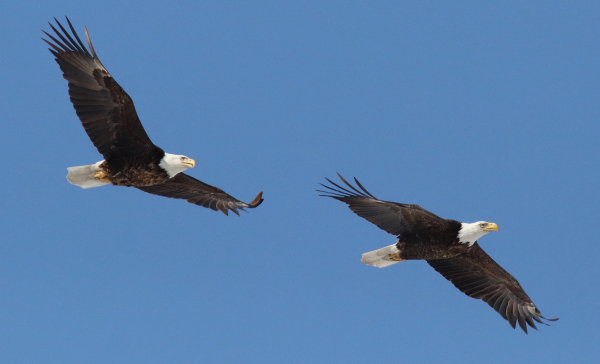
Saturday morning’s photo session provided a special opportunity to follow the flight of an adult pair of Bald Eagles through my camera lens as they flew quickly in tandem, turning abruptly to one side, then the other; flying upward, then diving; flying closer, then leaving my line of sight, and eventually returning – how exciting! (600mm zoom lens, f-8 aperture, 1/4000 shutter speed, 800 ISO.)
My previous Bald Eagle photo trips to the borderlands were afternoon sessions, so Saturday morning the direction of the sunlight was flipped, and while driving I wondered how that would affect photography and how I would adjust. No problem; but the importance of visiting the eagles in the morning was so I could return to the 2 best photo locations. Because of the wet, snowy, slushing backroad conditions during the warmer afternoon hours, it was imperative to arrive while the dirt roads and snow were still frozen by temperatures between 20 and 30 degrees. Even then, there was only evidence of a single previous tire track in the snow across the middle of each of the little-traveled rural roads, and they appeared questionable even while frozen.
It all worked out road-wise and driving-wise, luckily; but upon arriving at the borderland marshes it was clear there were fewer eagles on hand, and my first side road drive was a bust photographically. Even so, there were many more Bald Eagles there than anywhere else I’ve ever been, and I began to count eagles for the first time in 10 days. The birds I could see in northern group added up to 96 with a photo total of zero – hmm. But the best was yet to come, I hoped; and indeed I was in store for another fast and furious photo session at the southern-most Bald Eagle hangout where more eagles would wow me.
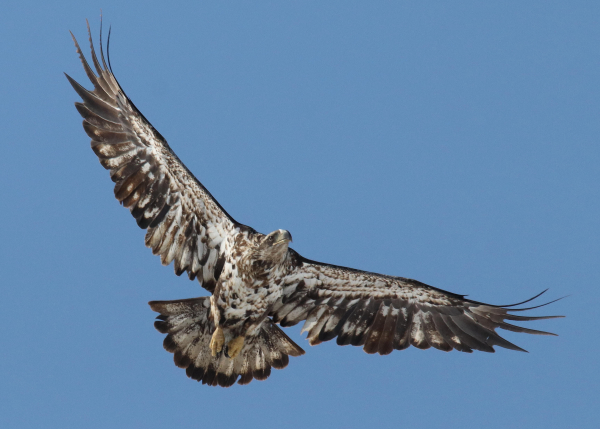
An especially dramatic view of a “white-belly” Bald Eagle from below was enhanced by the reflection of sunlight upward from a field of snow (600mm zoom lens, f-9 aperture, 1/3200 shutter speed, 800 ISO).
The trick this time was that rather than having the eagles before me with the sun at my back as I drove down the tree-lined lane, the morning sun was on the opposite side of the eagles as I approached the best photo site. Even so, eagles were flying above the treetops, and the birds that flew to the north and west, provided some nice photo opportunities, and some even circled low. That’s when I realized the added quality of the morning light: The snow helped to reflect the sunlight upward, enhancing the brightness and colors of the eagles, especially on their underside plumage.
I eventually made my way to the end of the trees, where the road turned south, knowing that was a prime flight path for eagles. After searching for food along the wetland directly to the east, some eagles were interested in perching in the mature trees, or in using the updrafts off the trees to propel to locations farther west and northwest. I eagerly positioned myself with the sun at my back in the midst of the broad eagle pathway, and even before I hopped out of the car eagles were flying into the focus area, immersing me in a very special photo session.
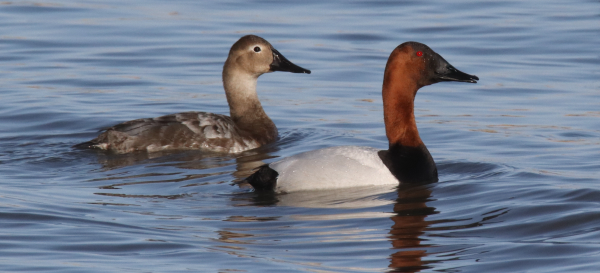
Close to home, several species of ducks were vying for mates, including this pair of Canvasbacks, with the male holding its head high and calling quietly to the beautiful female. The calm water and its striking color add much to the setting of this intimate photograph (600mm zoom lens, f-9 aperture, 1/3200 shutter speed, 800 ISO).
In addition to eagles flying back and forth between the marsh and trees, an even bigger flight of Bald Eagles began using the updraft off a second tree grove to the south to glide in my direction toward the mature trees. At times, the eagle action was so fast that I found myself choosing between which of 3 or 4 eagles to focus on as they winged above the snow-covered field in front of me.
Every once in a while, a low-flying eagle would take the time to circle above me, giving me a chance to follow its movements as it turned into the sunlight: First tipping to show its back and the top of its wings and tail, then slicing a circle’s edge to face toward me with one wing high, while continuing to cross in front of me as the sunlight illuminated its underside. Then too, in some cases the sunlight reflected upward from the snow-covered field to highlight the eagle’s plumage. And while none of the eagles I photographed called, others that were perched in the trees were calling, adding immensely to the depth of my immersion in this eagle magic – what a thrill!
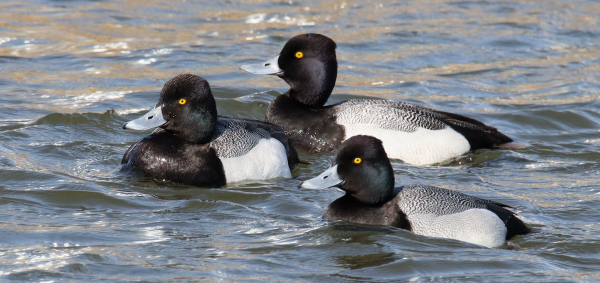
With a variety of colors reflected in this wind-swept water surface, a trio of Lesser Scaup drakes bounced in the wave action. A wider f-9 aperture provided an wider area in focus to include all 3 of the ducks (600mm zoom lens, f-9 aperture, 1/1000 shutter speed, 800 ISO).
Among the southern group, I counted 85 eagles, and there was another 17 at Hecla Marsh, which added up to a total morning count of 198 Bald Eagles. That was clearly a minimum count of the eagles on hand, but it underlines how exciting this epic birding episode was. Where else are you going to find a couple hundred Bald Eagles on a sunny Saturday morning? Sunny, but really cold, with the west wind blowing snow-cooled wind into my face that kept me hopping back into my car periodically, until the next eagles approached.
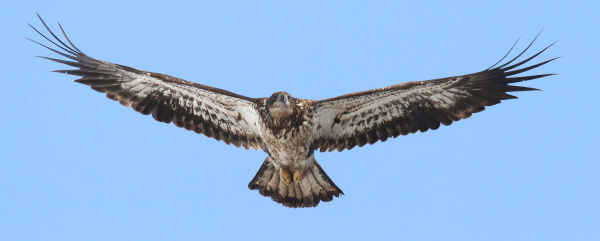
Approaching head-on from above, the fully spread wings of this second year Bald Eagle provides a dramatic view of a favorite American raptor (600mm zoom lens, f-8 aperture, 1/2000 shutter speed, 800 ISO).
About 11:00 I knew I needed to escape the deserted road that was showing some melting with muddy surfaces in spots, but with my eagle photography interest nearly satiated I was good to go. At that point I imagined I would be back to the office to catch up on this week’s issue by 1:30. But you know how it goes with me – there were distractions along the way – a dark morph Harlan’s Red-tailed Hawk, flocks of feeding geese, a pair of plains Red-tails. I also checked Charo Marsh as I re-entered my home court, where I was surprised to find at least 700 Snow Geese with about 60 White-fronted Geese on hand; plus 18 Tundra Swans and a variety of ducks too, including some obvious flocks of Canvasbacks, Gadwalls, Northern Pintails, Lesser Scaup, and more.
By that time I figured I’d make it back to work by 3:00, but a mile south of the office a large flock of Snow Geese feeding in a harvested field side-tracked me, with more Snow and Ross’s Geese with White-fronts resting along the bay shores of Melody’s Marsh. I stopped to photograph some moments at each location, but that excited me to check out the roadside wetlands up to 5 miles north of home – and that’s when my return time really went out the window. The excellent series of 4 marshes to the north provided opportunities to photograph courting groups of Ring-necked Ducks, Canvasbacks, Hooded Mergansers, Lesser Scaup, and Redheads, while trying to get an image or 3 of Common Goldeneyes, Common Mergansers, and Northern Shovelers among others.
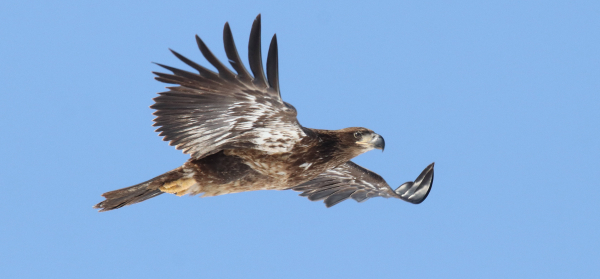
It’s always rewarding to see a circling eagle looking at you at eye level, and this image made me wonder if this yearling Bald Eagle had ever flown so close to a person before (600mm zoom lens, f-9 aperture, 1/1600 shutter speed, 800 ISO).
After all, there was prime afternoon sunlight for photography, and the wind was calming to add the beautifully colored water as an element in the duck photographs. Headed for the office again, I was within 2 miles when I was almost startled by the sight of a pair Tundra Swans feeding in the shallows close to a prime photo turnoff. The light was beautiful and so were the big swans as each one gracefully dipped its head below the blue water surface and churned the substrate with their huge black webbed feet. Joined by Canvasbacks that reaped the benefits of the swans’ churning activities, photographing the swans was a great way to end the day. But why stop now?
I passed by my office once more, interested in checking back on the feeding Snow Geese, only to find that they had relocated to Melody’s Marsh, filling in along the shoreline to within 40 feet of the roadway. I passed the geese slowly and stopped where the sunlight was best to photograph birds along the shore, in the water, and in flight as they approached to land among the expansive flock. It was a great assortment of photo ops available at prime time – how could I resist? One of the most interesting revelations was that there was a much higher percentage of Ross’s Geese among the post-April Fool’s snowstorm flocks of Snow Geese, and it was doubly interesting to see how accepting the geese were of my relatively close position. Although I’m always cautious not to disturb birds, they often seem to be extra trusting when my white auto appears a safe distance away.
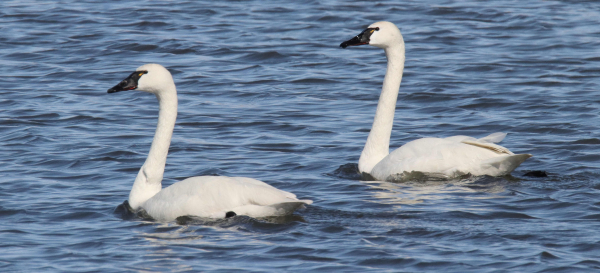
A matching pair of Tundra Swans provides a simple focal point that may be more of a documentary photograph than a feature illustration, but these grand waterfowl always demand attention when experienced in close quarters (600mm zoom lens, f-10 aperture, 1/3200 shutter speed, 800 ISO).
I finally made it home at 5:30, just 4 hours after my initial return time expectations, but sometimes it’s best to go with the flow; and Saturday was proof-positive of that. In my heart I knew I was doing what I should be doing, from the morning’s drive to eagle haven to my return to the local waterfowl extravaganza. You can’t buy days like Saturday, you can only appreciate them and make the most of them, especially if you are in birding mode with your camera in hand. Heck, I’m pretty good at working evenings; in fact, it was a very creative time for me to catch up after “an ultimate photo Saturday.” Take advantage of your free heart and open mind during your next bird photography outing, and Good Luck!
Article and Photographs by Paul Konrad
Share your bird photos and birding experiences at editorstbw2@gmail.com